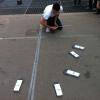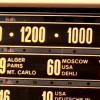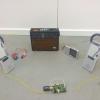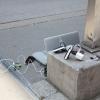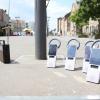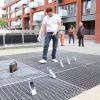Oscillating Cities
Osciallating Cities is a dynamic sound environment built from local radio, field recordings and internet radio from distant locations retransmitted over FM. It was performed on the square at Comte de Flandres, Brussels in June 2014. During the performance a corner of public space was re-imagined as a dense, contained sonic space, rich with hidden signals made audible by multiple radio receivers.
DOCUMENTATION AVAILABLE AT
video: http://www.youtube.com/embed/ECeQSZnKmKE?t=5m25s
audio: https://soundcloud.com/wordthecat/oscillating-cities
System
The system was set up as above. All the radios were battery powered and we therefore able to be moved around the space. Although the radios weren't able to produce a lot of volume, I got around this by tuning multiple radios to the same frequency.
Detailed information on how to set up PiFm on the Rasberry Pi can be found here. To make the devices as self sufficient as possible I added code to the file /etc/rc.local which would run PiFm in the background at startup. For playback I created a sox object which played back a wav file of field recordings made during the week. The wav was created at a 22k sample rate. This is the sample rate at which the Pi processes audio. An earlier attempt to play back a 44k wav file led to my recording being played back at half speed - an interesting, but, for this project, not desirable result. The process was repeated for the second Pi with a different file and transmission frequency.
One interesting thing to note about the PiFm technology is that the analog pin specified by the code is in fact oscillating at a speed in the Mhz... it is physically transmitting the audio as a radio signal. This is a really neat way of imagining the physical space being created by the performance. The range of the antenna can be extended with a longer wire. For this performance we used a short female to female jump wire on the pin which gave a transmission range of around 100m.
Content
The two sets of field recordings were made in the streets around the performance site in the week leading up to the performance. One set was recorded in a busy fruit, vegetable and clothes market. The other was made in a public square following Belgium's world cup victory over Algeria.
I chose to stream Radio Rwanda (from Kigali) to the laptop and run it through several delays and resonator objects in Max/MSP. It was largely talk radio (in French). The rhythm of the speech (+ delay) provided a nice counterpoint to the field recordings. Lately I'd also been reading a lot about Rwanda and the geopolitics of the African Great Lakes region in the 90s and early 00s. During this period Rwanda existed as a state with an extremely powerful army which could influence domestic politics in its much larger neighbours. This was a nice metaphor for the influence a single transmission can exert on space when it is retransmitted, processed and amplifed.
The second transmission was Radio Banha from Cairo. This station plays arabic pop music. Compositionally it was a nice way to end the performance, bringing a recognisable musical signal out of retuned noise. The fact it was an arabic station was significant because of the large north African population in the square and the areas surrounding it.
Passes between this content was achieved with the dial radios which were open to improvisation. During the performance they chanced upon FM noise and local French language content.
Between all these sources a specific and very physical space was created. It was physical in the sense of the physical transmissions of my FM modules, but also in the arrangement of radios which were moved around during the performance and brought in and out range of the transmitters, thereby using space and placement as way of degrading and modifying the sonic content.
Info
Date: June 2014
Last updated: January 2015
